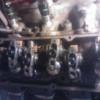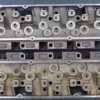Probably what is in there cam wise is a hydraulic lifter, 280 advertised duration, 224 or so at .050, moderate overlap, maybe 62 degrees.
Gives a rump rump muscle car sound, idles decent, peaks around 6000 rpm.
Lift is probably somewhere between .500 and .525 with 1.72:1 ratio rocker arms.
Installing 1.90 rocker arms gives you more valve lift without changing any of the other timing events.
With that ratio you increased the valve lift a little over 10%. So if there was a .525 lift, it's now at .5799". That's the reason the arms were changed, for more lift.
Even with the "good" Aussie 2v heads, a cam with that much lift is wasted. They top out pretty much around .500 lift.
All they are doing is making more valve train wear needlessly.
I'd change them to the stock ratio and sell those rockers on ebay. Someone will be interested in them.
It would be interesting to find out if the heads had port work done to them. With any 2v heads that would be a plus.
The 2v heads aren't my favorite. You can clearly see a car that has them, on a road course (race track) from a distance trailing the pack or noticeably down on power.
In a strictly street car, unquestionably they crispen the throttle BUT at the expense of the top end.
There are enough people using them in autocross or even circle track racing to show that they can support somewhere around 450hp with nice torque, so they definitely are not garbage at all, but they take a good deal of port work to make them acceptable. Out of the box, they are not.
They are just items never intended as high performance parts from a bi-gone era. There are so many better compromises available now in heads for the Cleveland.
I'd leave the cam in there and just change the intake and rocker arms UNLESS I was going to change the heads too. Then that's a different story and there are other considerations to make a viable package with complimentary components.
It all depends on how you see the nature of your Pantera and what you want to use it for. No one here can make those decisions and build it for you.




